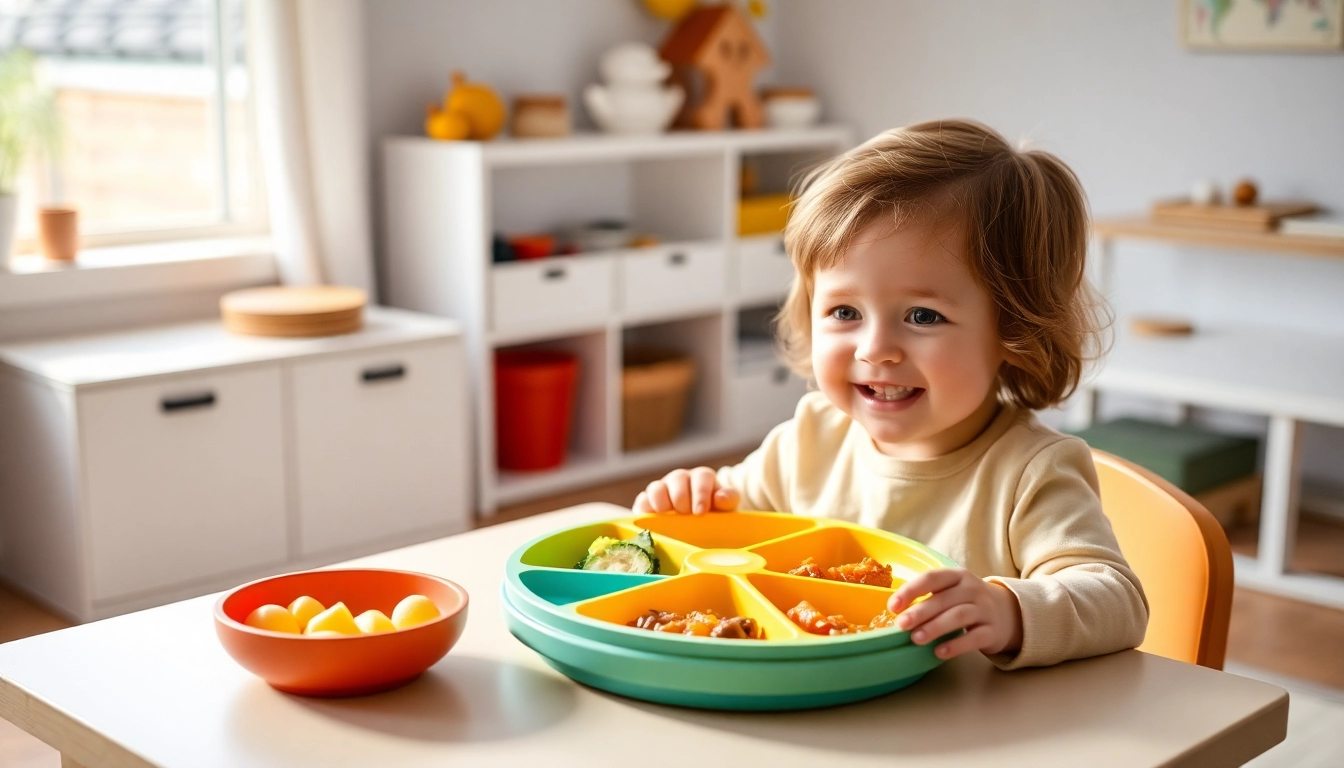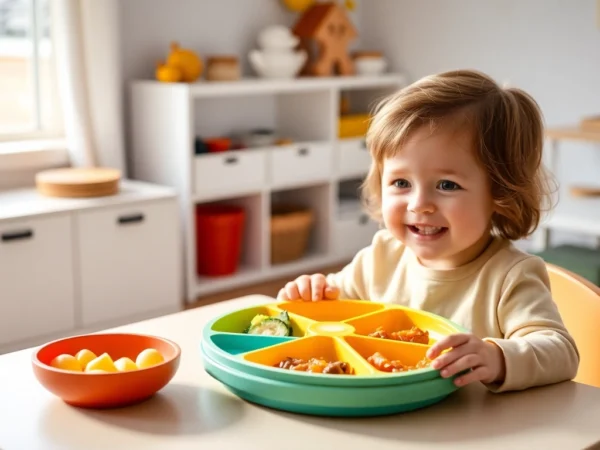How to Choose the Best Silicone Divided Plate for Self Feeding to Support Your Child’s Development
Understanding the Benefits of Silicone Divided Plates for Self Feeding
Self-feeding is a crucial milestone in a child’s developmental journey, fostering independence, motor skills, and healthy eating habits. Among the essential tools that support this phase, silicone divided plates have gained popularity for their safety, design, and practicality. These plates are specifically engineered to encourage toddlers to explore their food, develop fine motor skills, and enjoy mealtimes with greater autonomy. For parents seeking the best options, a silicone divided plate for self feeding offers a perfect combination of safety and functionality, making mealtimes more engaging and less stressful.
Why Silicone is the Ideal Material for Baby Plates
Silicone has become the material of choice for children’s tableware due to its unmatched safety profile and versatile properties. Unlike plastics that may contain harmful chemicals such as BPA, phthalates, or lead, food-grade silicone is certified to be free from these toxic substances, ensuring that no hazardous chemicals leach into your child’s food. Its heat resistance allows it to withstand high temperatures during sterilization, while its flexibility makes it resistant to cracking and breaking, unlike traditional porcelain or glass plates.
Moreover, silicone is non-porous, which means it resists the buildup of bacteria and mold, simplifying cleaning and maintaining hygienic conditions. Its durability extends over many uses, making it a cost-effective long-term investment. The soft, rubber-like texture also provides a pleasant tactile experience for babies just beginning to explore their senses.
Key Features that Promote Independent Eating
Silicone divided plates are thoughtfully designed to promote a child’s independence during eating. These features include:
- Multiple Compartments: Designed with separated sections, these plates help portion food, prevent mixing, and encourage exploration of different flavors and textures.
- Non-slip Base: Equipped with a ventosa or suction base, these plates firmly adhere to the table surface, reducing the chance of spills and messes, allowing children to confidently manipulate their food.
- Accessible Edges and Rims: Rounded, easy-to-grip edges facilitate self-feeding, encouraging children to grasp and pick up food independently.
- Flexible yet Stable Material: The silicone’s flexibility assists children in managing their plates and food, especially when learning to feed themselves.
These design elements foster a sense of autonomy, essential for building confidence and encouraging children to try new foods without parental intervention.
Safety and Certifications Every Parent Should Know
Ensuring the safety of children’s tableware is non-negotiable. Reputable silicone plates are produced under strict certification standards, including compliance with FDA, EU Food Contact Material regulations, and other global safety protocols. These certifications guarantee that the silicone used is food-grade, BPA-free, phthalate-free, and free from harmful additives.
At Bebeboom, all silicone accessories and plates are certified, reflecting Italy’s high standards for food safety and quality. Choosing products with such certifications provides peace of mind that your child’s health and safety are prioritized, especially during the sensitive stage of self-feeding.
Choosing the Right Silicone Divided Plate for Your Child
Designs and Functionalities to Look For
When selecting a silicone divided plate, consider the design elements that support your child’s needs. Key functionalities include:
- Shape and Size: Opt for plates that fit well in small hands and are proportionate to your child’s age and eating skills.
- Number of Compartments: Many plates feature three or more sections, accommodating different food groups and helping manage portion sizes effectively.
- Ease of Use: Plates with smooth, rounded rims or accessible edges facilitate independent gripping and scooping.
- Stability Features: Look for plates with built-in suction cups or ventosas to prevent slipping or tipping during meals.
Prioritize designs that are visually appealing, ergonomically friendly, and align with your child’s developmental stage to maximize mealtime success.
Size, Compartments, and Ease of Use
Choosing the correct size and configuration of a divided silicone plate hinges on your child’s age and motor skills. Younger toddlers benefit from smaller-sized plates with fewer compartments, aiding concentration and ease of manipulation. As they grow, larger plates with more sections can inspire exploration and self-serving behavior.
Ease of use is equally crucial; features like pliable but grippy edges, simple suction mechanisms, and lightweight construction promote autonomy. The ability to detach or clean individual compartments easily also enhances functionality, allowing parents to maintain hygiene effortlessly.
Matching Plate Features to Your Child’s Age and Eating Skills
Developmental milestones influence how children interact with their plates. For infants just beginning to self-feed, small, shallow compartments and plates with a firm suction base are ideal. As fine motor skills improve, larger plates with deeper compartments and adjustable suction mechanisms accommodate more coordinated movements.
It is essential to observe your child’s progress and choose a plate that adapts to their evolving skills. For example, a Rainbow Bebeboom silicone plate in a rainbow shape with removable compartments can serve both early and intermediate stages of self-feeding, promoting engagement and independence.
Implementation Tips for Using Silicone Divided Plates Effectively
Introducing the Plate During Mealtimes
Introduce the silicone divided plate gradually during regular mealtimes, demonstrating how to place food in each compartment and encouraging your child to interact with it. Use positive reinforcement to boost confidence and curiosity. Starting with familiar foods on the plate can increase their willingness to explore new textures and flavors.
Encouraging Self Feeding and Motor Skills
Support your child’s development by allowing ample opportunities to practice self-feeding. Offer utensils suitable for their age, such as ergonomic silicone spoons and forks, encouraging them to scoop, pinch, and transfer food. Highlight the importance of consistency in mealtime routines to foster confidence. For example, using catchy phrases like “Time for lunch!” helps establish a predictable and comforting environment.
Remember that patience and gentle guidance are vital. Celebrate small successes to motivate continued effort and mastery of new skills.
Cleaning and Maintenance for Long-lasting Use
Maintaining your silicone plates involves simple cleaning procedures. Most silicone products are dishwasher safe, but hand washing with warm, soapy water is recommended for longevity. Ensure that suction bases are thoroughly cleaned to avoid loss of grip. Regular inspection for tears or deformation is also recommended to ensure safety.
Proper care ensures your child’s plate remains hygienic, visually appealing, and fully functional, supporting a sustained positive mealtime experience.
Overcoming Common Challenges with Self Feeding Plates
Dealing with Spills and Messes
Spills are a natural part of early self-feeding. Using plates with non-slip bases significantly reduces messes. Additionally, placing a protective mat or easy-to-clean surface under the plate can contain accidents. Encouraging your child to use utensils, along with patience, will gradually minimize spills over time.
Ensuring Proper Placement and Stability
Stability issues often occur when plates slide or tip. Choosing plates with robust ventosas or suction cups ensures adherence to flat surfaces. Proper positioning and pressing down the suction base firmly before mealtime help maintain stability. For uneven surfaces, select plates with adjustable or enhanced gripping features.
Addressing Food Transfer and Plate Displacement
Children may transfer food to their hands or displace plates during active feeding. Using ergonomic, textured edges and well-secured suction bases reduces this tendency. Reinforcing with role-modeling and guiding your child to return food to the plate fosters better habits and confidence in controlling their movements.
Enhancing Feeding Experience with Complementary Accessories
Recommended Utensils and Cutlery for Self Feeding
Complement the silicone divided plate with ergonomically designed utensils such as soft, non-slip silicone spoons and forks. At Bebeboom, we offer sets of cucchiaino e forchettina in silicone, tailored to small hands and sensitive gums. These encourage proper gripping, improve dexterity, and facilitate independent eating.
Complementary Products to Promote Enjoyable Mealtimes
Adding joyful, colorful accessories like rainbow-shaped silicone plates or soft-edge bowls can make mealtimes more engaging. Personalization options, such as stickers or monograms on dishes, can foster a sense of ownership and pride in eating independently.
Personalization Ideas to Engage Your Child
Personalize plates with your child’s favorite colors, characters, or themes to inspire enthusiasm. Using themed placemats, cheerful utensils, or adding special stickers fosters a positive association with mealtime and encourages self-feeding routines.


